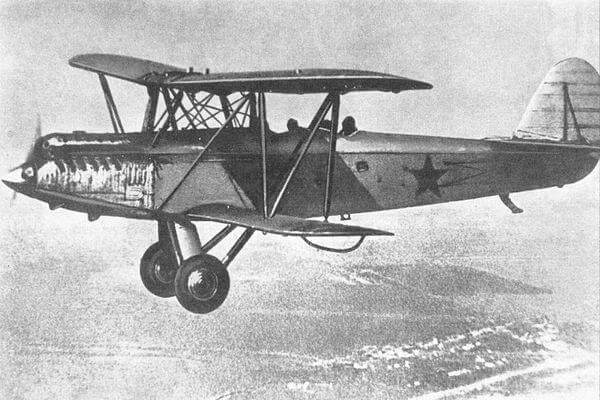| Type |
Werk.Nr |
Registration |
History |
|
|
|
|
| Type |
2-seat reconnaissance bomber |
| Engine |
1 Mikulin M-17B with 2-bladed fixed-pitch propeller |
| Dimensions |
Length 10,56 m, height 3,25 m , span 15,5 m, wing area 50,2 m2 , airfoil Clark Y ( 10 % ) |
| Weights |
Empty 1969 kg, loaded 3247 kg , max. take off weight |
| Performance |
Max.. speed 228 km/h, cruising speed , range 800 km, endurance , service ceiling 6400 m , climb to 1000 m 2 min. 6 sec. |
| Armament |
1 fixed forward firing PV-1 machine gun and 1 DA machine gun in rear cockpit Bombs: 250 kg bombs on bomb racks |
The R-5 was developed by the design bureau led by Nikolai Nikolaevich Polikarpov as a replacement for the R-1(an unlicensed version of the DH.9A built in Russia) which served as the standard reconnaissance and light bomber aircraft with the Soviet Air Force.
The prototype first flew in autumn 1928, powered by an imported German BMW VI V-12 engine. It was an unequal-span single-bay biplane of mainly wooden construction.
After extensive evaluation, the R-5 entered production in 1930, powered by the Mikulin M-17, a licence-built copy of the BMW-VI, as a reconnaissance bomber. Further modified versions were produced to serve as floatplanes, ground-attack aircraft and civil transports.
The R-5SSS, an improved reconnaissance bomber with improved streamlining, served as the basis for the Polikarpov R-Z, which succeeded the R-5 in production.
The aircraft R-5 was designed by Nikolai Polikarpov in 1928. The aircraft was taken into the Soviet Air Force's use in 1931. They operated 5,000 aircraft R-5.[citation needed] Over 1,000 aircraft simplified for civilian needs were manufactured for Aeroflot under the designation P-5
The R-5 became the standard reconnaissance and attack aircraft with the Soviet Air Force, being used in large numbers, with over 100 regiments equipped with the R-5. R-5s served with the Soviet Air Force and Mongolian People's Air Force during the 1939 Battle of Khalkhin Gol fought against the Japanese and, took active part in the Soviet invasion of Poland (1939), and the 1939-40 Winter War against Finland, where they were known as the hermosaha ("nerve saw"). The Finns downed and captured several R-5s, but none were taken into operational service. They remained in service during the war against Germany in 1941-45, where they were mainly used as night bombers and liaison aircraft, serving until 1944.
The Chinese province of Xinjiang received a number of R-5s in 1933, and when a rebellion threatened to overthrow the pro-Moscow governor of Xinjiang, Sheng Shicai, the Soviet Union intervened, with Soviet-flown R-5s bombing rebels near Ürümqi. R-5s remained in use for training purposes in Xinjiang in 1938.
R-5s were also used by the Spanish Republican Air Force in the Spanish Civil War, 31 being sold to Spain. These arrived in November 1936, and were quickly deployed on combat operations, but were found to be slow and were relegated to night bombing. Seven R-5s remained in good condition in March 1939. The aircraft was known as the "Rasante" (roughly translated as "Low flying") in the Spanish Republican Air Force.
Civil versions of the R-5 were used in large numbers, mainly by Aeroflot. They were used to carry up to 400 kg of freight, with many being fitted with an enlarged rear cockpit to carry two passengers. Other aircraft were fitted with enclosed cabins for passengers. P-5s could also be used to carry underwing containers (or Kasseta) for freight or passengers with one P-5 carrying 16 adults, including seven in each Kasseta.[3][8] Ski-equipped P-5s carrying Kasseta paid a key role in the rescue of the crew of the icebound Soviet steamship Chelyuskin in 1934. Civil R-5s remained in service until after the end of the Second World War.




